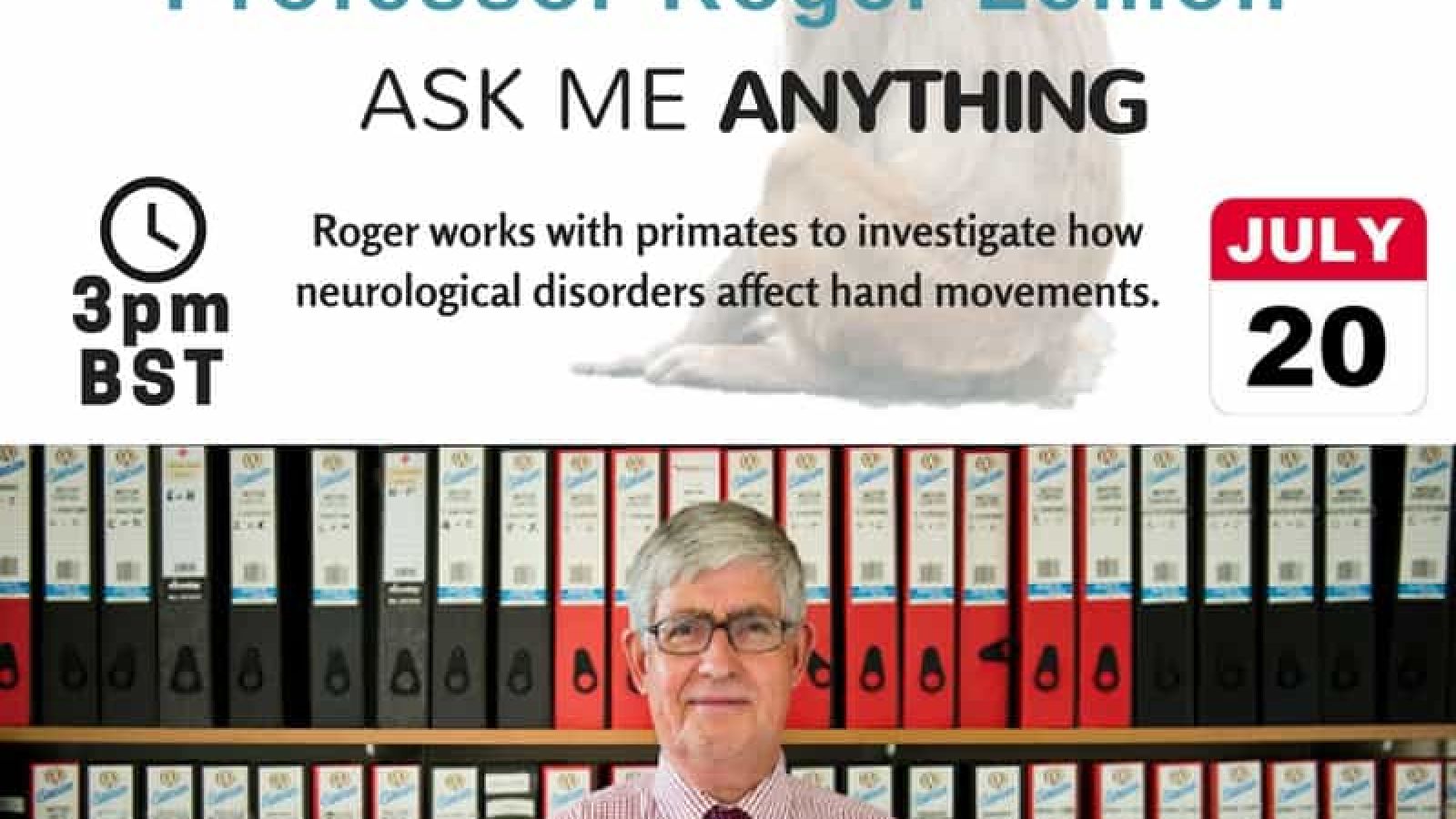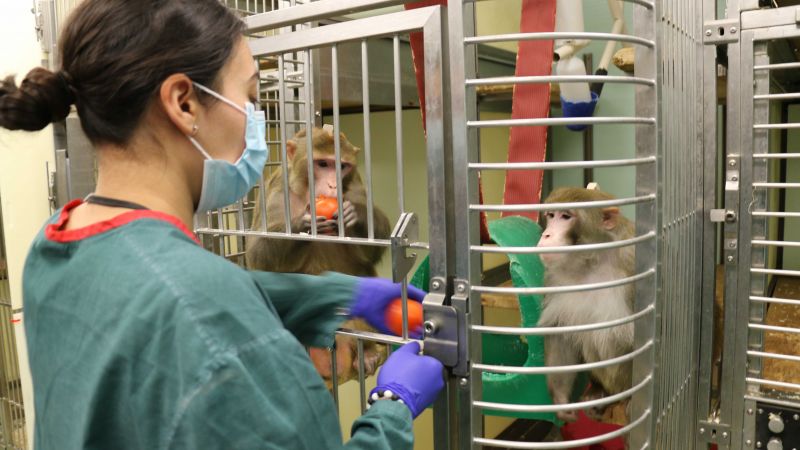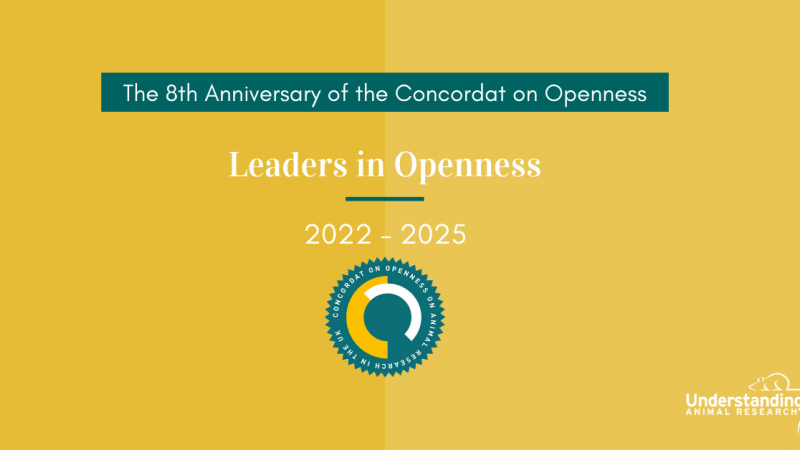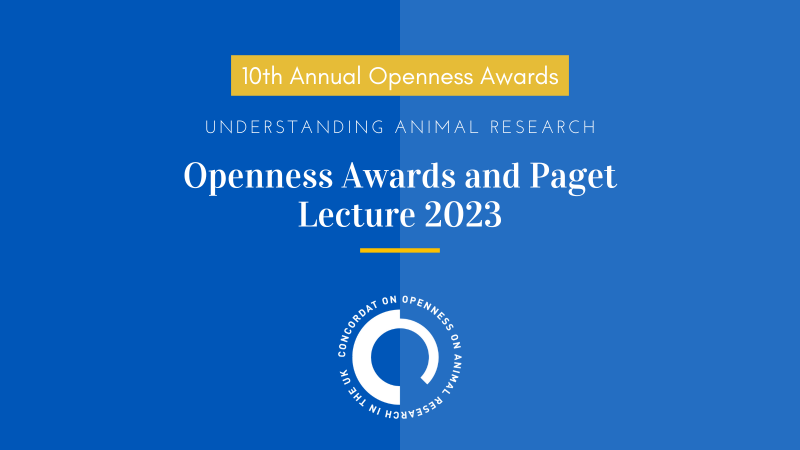On Thursday 20th July, Understanding Animal Research organised a Reddit ‘Ask Me Anything’ (AMA) with Prof Roger Lemon.
Roger is a just-retired Professor of Neurophysiology at the Institute of Neurology, UCL, where he worked for 22 years. His main research interest is the control of skilled hand movements by the brain and is prompted by the need to understand why hand and finger movements are particularly affected by damage to the cortex, and its major descending pathways, for instance as a result of stroke, spinal injury and motor neuron disease. His experiments involve the use of purpose-bred non-human primates (NHPs), since these provide the best available model for the human sensorimotor system controlling the hand.
Nearly 300 questions were submitted by Reddit users throughout the AMA, covering a variety of topics such as the use of NHPs in scientific research, and the implications of Roger’s work. Roger responded to 18 questions during the session, including a popular question amongst Reddit users about NHPs learning sign language.
“…it is true that both apes and monkeys can learn some forms of sign language and there have even been some studies of some rhesus monkeys where they draw and copy simple outlines (such as a figure of 8).”
In a question referring to primates being ambidextrous, Roger pointed out that, unlike humans, primates use both hands to perform tasks but favour a certain hand for a certain function, instead of always using the same hand.
“…most of the monkeys we work with seemed well able to perform the skilled tasks with either hand. I think it is generally recognised that monkeys show hand preference for particular tasks e.g. using a tool, but they do not show hand dominance (which means you always use one hand, right or left, for all the tasks you carry out). Humans show hand dominance, but monkeys show hand preference. They may change their preferred side according to the task they are carrying out.”
Many Reddit users were interested to know how hand movement is controlled. When speaking about what areas of the brain are involved, Roger said:
“Non-invasive human brain imaging has revealed that there are many different brain areas involved in hand movements. These include the cerebellum, the basal ganglia and the cerebral cortex. Neurologists who study patients with damage to these different areas have concluded that none of them is absolutely essential, but damage to any of them will degrade the quality of the movement made. For example, cerebellum damage will induce uncontrollable tremor and cortical damage leads to a poverty and weakness of movement.”
On the subject of animal research, Roger spoke about NHPs being an appropriate model for his work as “both human and monkey brains are very similarly organised”, and how “research in NHPs is quite rightly very carefully regulated”.
“There are important differences and similarities between the human brain and the brain of, for example, the rhesus monkey, which is the main model which I have used in my research. The similarities include the fact that both human and monkey brains are very similarly organised in terms of the motor map within the brain and the connections the motor cortex makes with the spinal cord and the motor neurons that control the muscles… I am absolutely certain that our knowledge of the human motor system would be very poor indeed without the wealth of neuroanatomical and neurophysiological studies carried out in monkeys.”
“In the UK, research in NHPs is quite rightly very carefully regulated. NHPs can only be used in scientific research when no other species is appropriate. There are extra controls on issues such as breeding, weaning, transport, accommodation, health and welfare of experimental monkeys. Every licence for NHP work is subject to rigorous assessment from the Animal Welfare and Ethical Review Body (AWERB) and subsequently by the UK Home Office. Because of the sentient and valuable nature of NHPs, the standards for care and welfare are constantly being revised and upgraded. In particular, scientists and institutions are taking on board new procedures which refine the use of primates in experiments.”
Roger went into detail about the specific tasks NHPs performed in his research, how they were trained and the pros and cons of working with this species.
“Most of my research was carried out using purpose-bred Macaca Mulatta (Rhesus) or Macaca Nemestrina monkeys. The tasks we used were designed to elicit the most skilful hand movements we could from these monkeys. In many studies monkeys were presented with manipulanda which required independent movements of the index finger and thumb to move levers into a narrow target zone and hold them there for a second or so. Successful trials were rewarded with either fruit, nuts or pulses (e.g. sunflower seeds). Highly trained monkeys could complete up to a thousand trials of these tasks in a day and so you can imagine we had to carefully control reward size to avoid them becoming obese.”
“… nearly all of my research has involved monkeys carrying out trained tasks for food rewards. Training the monkeys is done with positive reinforcement and we never use aversive, or painful, punishments for poor performance. Most monkeys welcome the opportunity to perform their tasks, since they are naturally curious and task performance represents a break from a relatively boring cage life. Despite the fact that their cage environment is enriched and constantly changed, they still seem more than happy to come out and work when required.”
“… My most favourite aspects of working with monkeys is that they are amazingly curious and friendly animals with whom you can build up a really strong working relationship over the period of the experiment, which was often several years. As you can imagine the major downside of this research is when the experiment has to come to an end. I should point out that post-mortem studies were always essential to confirm the areas of the brain from which we had been collecting data. In these experiments monkeys undergo a number of complex surgical procedures. All of these procedures are carried out under deep general anaesthesia with full aseptic control (i.e. sterile conditions) and with a full programme of post-operative painkillers. Over the course of my career I have seen that new methods of anaesthesia and surgery have resulted in monkeys being able to make faster recoveries after surgeries.”
Roger’s research involved the use of purpose-bred NHPs. When asked about it during the AMA, he said:
“In the UK all monkeys that are used for basic research are purpose bred in the UK. The numbers involved are usually in the order of 250 monkeys per year. For work in neuroscience a great deal of effort has gone into preparing rhesus macaques to be suitable for use in experiments which typically require a great deal of skill and intelligence to perform challenging cognitive and motor tasks. For example, monkeys are introduced at a young age to positive reinforcement techniques in which they are rewarded for performing simple actions such as pressing a button or touching a particular part of the cage. Remarkably, these monkeys can be conditioned to every requirement of the experiment provided you are willing to be patient long enough for the monkeys to understand what has to be done in order to obtain a reward. I have never done any research with wild caught monkeys so I cannot comment on any differences. I can say that purpose-bred macaques are amazingly smart and much faster than humans. For example, we trained monkeys to use a rake to obtain food rewards that were placed out of their reach and they learned this task within 12 sessions and were able to collect many rewards within a minute with no trouble.”
The 3Rs (reduction, replacement and refinement of animals in research) play an important part in Roger’s work and he states that “this work should only be carried out with careful regulation that ensures responsible, high-quality research and requires the highest possible welfare standards, driven by application of the 3Rs”. He spoke about the importance “of social housing for all experimental monkeys (where all monkeys share their cage with at least one other)” being introduced as a refinement example. And while the number of primates in research is declining, their use remains crucial as current alternative methods are not yet able to replace the use of animals in this area of research.
“Take a look at the EU's SCHEER report. This report concluded that research in non-human primates will continue to be needed, but also lays great emphasis on alternative non-animal approaches. If you look at the numbers of monkeys used in basic research over the last few years you can see a steady decline in numbers that fits with the use of these alternative methods. I personally believe that a better term for these approaches is 'complementary' because we need to combine research in the monkey with, for example, computer modelling and non-invasive work in human volunteers and patients. For example, it was work in monkeys that discovered the fundamental role played by Dopamine in brain activity related to rewards and this work has been incorporated into very successful computational models and these models can help to explain how the reward system malfunctions in various brain states such as depression.”
Roger also stated that he has “always avoided the infliction of unnecessary pain” to the research animals and that he would “try and find another way of using a less painful test or avoiding it altogether.” It’s important to remember that “all biomedical research inflicts some harms on the animals used and it is our duty as scientists to try to minimise those harms and at all times to make sure that the benefits of the research justify the harms inflicted.”
Due to the spread of misinformation online there are many misconceptions surrounding animal research. Roger addressed this by stating:
“An unfortunate legacy of the past conflict between scientists and antivivisectionists is the continuing presence, on the internet, of gruesome pictures of monkeys in experimental procedures. A popular misconception is that these procedures are still going on today. My experience, in the UK, is completely the opposite, and that our research is now characterised by a great deal of new refinements that have reduced the harms and improved the lives of our experimental subjects… I refer you to the Virtual Lab Tour and to the Macaque pages on the NC3Rs website. I think we are now moving into a more open way of explaining to the public the work we are doing, and why we are doing it. As a result I hope that these old, outdated, and misleading images will be recognised for what they are.”
Roger is “a strong advocate for better engagement between scientists and the public about how we use animals in science” and believes that being open and transparent about animal research will help the public to better understand this area of science.
“In the UK we have come through a period of intense anti-vivisectionist terrorist activity and have moved onto a more of a peaceful debate about the rights and wrongs of animal experiments. Of course I am grateful for that change. The UK now has the lowest levels of animal rights extremism that it is ever had. So it's important to use the current opportunity to try and persuade the public of the importance of medical research including that involving non-human primates. When I look at the contributions made by monkey research in areas such as infectious disease and neurological and neuropsychiatric disorders, I am more than ever convinced of the importance of retaining the monkey model. I am also convinced that by being increasingly open and forthcoming about the research that I do, I am actually decreasing the chances of my being personally targeted by the more violent members of the antivivisection community.”
Roger cited the UK’s Concordat on Openness and the recent Lab Animal Tour as examples of the UK’s increasingly open and transparent approach to talking about the issue, which is in turn helping the UK public to understand animal research better.
Roger “is firmly of the opinion that we still need some research in monkeys to understand the complex functions of the human brain” and the AMA gave insight into the importance of his “fundamental research aimed at understanding normal brain function in, for example, learning, memory, emotion and, my own research area, motor skill“.
Speaking after the event, Roger commented how he enjoyed the experience and would recommend it to other researchers.
“This was a novel and interesting experience for me. I am a complete novice to social media and had little idea what to expect from my first AMA: actually I was impressed by the huge range of questions (anything from fidget spinners to the size of neurons in the motor cortex). Most of those posing questions were very well-informed on the subject of motor control, but also on the dilemmas facing scientists using animals in research. It was a great opportunity to clarify and explain the nature of the work I and many others have carried out, and to try to convey the value of that work, mostly for advancing fundamental science, but also to aid translational medicine. My message would be: try it, well-worth the time and the effort“
If you would like to understand more about this area of research, Roger recommends reading The Hand: A Philosophical Inquiry into Human Being by Raymond Tallis.
This AMA follows successful sessions with Dr Karen Mifsud who spoke about her stress research during Stress Awareness Month, Professor Sir Colin Blakemore, following his Paget Lecture in December 2015, and UAR Chief Executive Wendy Jarrett, following the launch of the Concordat on Openness on Animal Research in May 2014. If you would like to take part in an AMA yourself then please get in touch with Hannah Hobson (hhobson@uar.org.uk) as UAR can offer support and guidance throughout the entire process.
To read all of Roger’s AMA, click here.
Last edited: 28 October 2022 15:09




